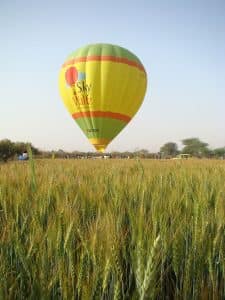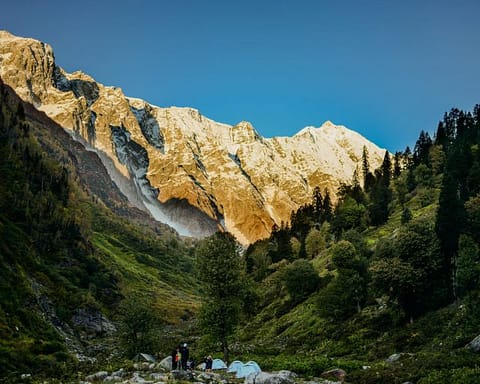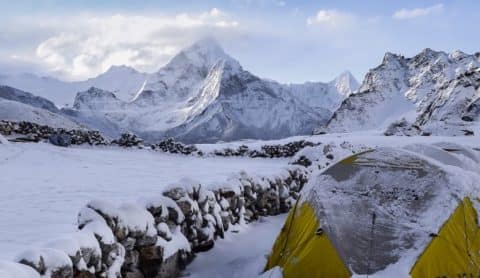
Tanya Roy
Tanya has always been an adventurous soul, starting from her childhood when she explored the depths of the seas in Tamil Nadu, Andaman, and Goa. She enjoyed swimming and scuba diving, which fueled her passion for adventure. Now, she identifies herself as a Himalayan Traveler, with her love for the Himalayas surpassing everything else. Solo traveling gives her a sense of exhilaration similar to meditation, and she prefers living outdoors unconstrained by boundaries. After backpacking for a few years, she realized that her true calling was trekking. She aspires to witness the highest mountains in the world but intends to honor them by not climbing them. Visiting all the base camps is on her bucket list. Tanya draws inspiration from the book “Wild” and dreams of solo hiking the Pacific Crest Trail someday. She enjoys writing about her travel experiences, connecting them to life’s philosophy, and firmly believes that “Life is either a daring adventure or nothing at all.”

Latest posts by Tanya Roy (see all)
Kashmir, a valley surrounded by the Pir Panjal and Himalayan mountain ranges, is renowned for its breathtaking beauty and is often referred to as the ‘Paradise on Earth.’ Thanks to its advantageous location and picturesque landscape, the region provides numerous trekking opportunities for tourists. Among these options, the Kashmir Great Lakes trek stands out as one of the top moderate treks in Kashmir. Situated above Sonmarg along the Srinagar-Leh highway, this trek offers captivating views of the untouched natural scenery.
Many people believe that the real beauty of nature can be found in remote, untouched areas that cannot be reached by roads. Surprisingly, the Kashmir Great Lakes, which consist of high-altitude lakes, meadows, and unique plant and animal species, have remained undiscovered for a long time. These stunning lakes have fascinating tales about how they were formed and why they are named after Hindu deities.

Some of the stunning lakes covered during the trek include Krishnasar, Gangabal, Gadsar and Vishansar. A magical view of ice sheets sliding off from the glaciers and feeding the alpine lakes is truly a feast for the eyes. And the icing on the cake is the sight of milky white ice sheet floating on the sapphire lakes.

- Experience the opportunity to discover five breathtaking glacial lakes located at elevated altitudes.
- Learn about the lifestyle, culture, and traditions of Kashmir.
- Indulge in the mouthwatering flavors of traditional Kashmiri cuisine.
- Observe the breathtaking view of mountains covered in snow, as well as the fascinating wildlife.
- Spend a night in the camp, which is set aside the cold blue lake and under the glittery sky
- An encounter with herders and their livestock, including cattle and goats
- Walk on the sharp gradient and pasture land with snow patches
- Traverse a path that takes you across lush fields, pristine ice formations, desolate rocky terrain, and rushing rivers.
Best time to plan your visit: The period from April to October is regarded as the optimal timeframe for embarking on the Kashmir Great Lakes trek. During this period, the delightful climate enables you to admire the picturesque mountains and the stunning valley.The daytime temperatures during these months typically range from 17°C to 20°C, while the nighttime temperatures range from 3°C to 4°C.
Region: Jammu and Kashmir
Duration: 8 days
Altitude: 4206.24 m
Trekking distance: 63 km
Difficulty level: Moderate
Minimum age: 10 years
Starting Point: Sonmarg
Ending Point: Naranag
Railway Station: Srinagar railway station
Airport: Sheikh ul-Alam International Airport
A Quick Recap of Elevation Points
The journey will start from the captivating hill station of Sonmarg and continue to Nichnai (3505 m). The path goes through dense forests, lovely streams, and a beautiful valley with green pastures. Trekking through difficult and rocky terrain, the next destination is Vishansar Lake (3657 m). The terrain will then lead to Gadsar (3657 m) by way of Krishansar Lake and Gadsar Pass (4192 m). The following day, while enjoying stunning mountain views, you will hike through steep slopes and rough mountainous areas to reach Satsar (3657 m). Follow the path that goes through a forest of coniferous trees to arrive at Gangabal Twin Lakes (3503 m). On the final day of the expedition, descend to reach a quaint village called Naranag (2270 m).
Trekking through the Sublime Beauty of Kashmir Lakes
Being an admirer of nature and its enchanting beauty, the Kashmir Great Lakes trek gave me lifetime memories of splendid nature residing in the abode of Sonmarg Valley. The trek is known for reflecting an astonishing contrast in the landscape that begins from lush green valleys and ends at the semi-arid and cold region of Naranag. A walk through dazzling meadows, alpine forests, grassland and glaciers made my journey truly enthralling and exciting.
After comprehensive research, I planned the trek with my childhood friends and booked our flights to Srinagar and then we packed our bags with all the necessary equipment like trekking pole and shoes.
On the first day, arrive at Srinagar and proceed with driving to Sonmarg.
We took a flight from Delhi to Srinagar at 9 am from Indira Gandhi International Airport. After admiring a beautiful sight of the sun shining through the clouds, we arrived in Srinagar in 1 hour and 15 minutes. Our guide was waiting for us at the arrival hall and welcomed us with a bouquet, saying Khush Aamdeed, which means you’re welcome. From there, we departed for Sonmarg and arrived in approximately 2 hours. Sonmarg is known for its picturesque green meadows and is said to be the last town in Kashmir before reaching Ladakh.

No rewording needed.kahwah with snacks, we were briefed about the trek by our tour representative. In the evening, we took a stroll in the town and found some singers who were singing melodious folk songs. Despite being unaware of the language, every word of that folk song was falling on my ears like a magic that was taking me to the ancient times. We clicked pictures with these women and also played pithooIn the evening, we enjoyed spending time with the kids. When it was dark, a delightful Kashmiri thali was served for dinner.
Day 2: Trek from Sonmarg to Nichnai
We woke up at approximately 6 in the morning. After eating breakfast, we were driven to Nichnai, which was only a few kilometers away from Sonmarg. In 35 minutes, we arrived at a spot where we had to begin our trek. At first, the trek involved a steep ascent towards a place known as Table Top. While hiking, we were able to see the breathtaking views of the renowned Sonmarg glaciers and the valley in the background. It was our first day of trekking, and climbing uphill proved to be challenging for us as some of us started experiencing difficulty in breathing.
Fortunately, we came across a dhaba (eatery) at Table Top, operated by a lovely Kashmiri couple. We stopped there for about 20 minutes, enjoying a cup of tea and snacks that provided us with the much-needed boost. As we continued our journey, the trail gradually led us into a valley filled with birch trees. By 2.30 pm, we reached Nichnai and discovered a picturesque campsite next to a flowing stream, where we promptly settled into our tents. Shortly after, we delighted in some tea, pakoras (fritters), and Maggi noodles. We spent the night in the campsite.
Day 3: Journey from Nichnai to Vishansar Lake | Day 4: Adjusting to the altitude
The following day, we embarked on a 30-minute hike along a stream adjacent to our campsite. The steep trail eventually led us to alpine grasslands. Within an hour, we stumbled upon a petite glacial lake, which provided the perfect opportunity for capturing numerous photographs. Subsequently, we traversed a flowing body of water known as River Beas and proceeded to ascend towards the Nichnai Pass. Along the way, we took regular breaks every hour to rest.
Afterwards, we made our way down to a stunning meadow that led us to Vishansar Lake. This lake, named in honor of Lord Vishnu, was incredibly vast and exquisite. Additionally, we were fortunate to witness the grandeur of the glaciers that supply water to this lake. Recognizing the significance of acclimatizing before proceeding further, we also allocated an additional day at a designated campsite near Vishansar Lake.
On the fifth day, we will embark on a trek from Vishansar Lake to Gadsar, passing through Krishnasar along the way.
If you attempt this trek, it will be the most extensive and most picturesque day on the trek. Following the crossing of Vishansar, we gradually ascend towards Krishnasar, the second stunning lake on this journey. This lake is named after Lord Krishna. Interestingly, our guide informed us that these lakes are classified as oligotrophic lakes by scientists, indicating they have abundant oxygen levels and minimal organic matter, making them suitable for drinking. After passing this breathtaking lake, we proceeded to scale towards Gadsar Pass.
The journey became more challenging as we faced mental and physical obstacles along the trail. We replenished our energy with drinks and bars while trekking. After approximately 2 hours of walking, we were rewarded with the breathtaking sight of Vishansar Lake. We continued our journey by crossing Gadsar Pass and descending towards Gadsar Lake. The path led us through a picturesque grassland adorned with colorful wildflowers. It was a fortunate day as we had the opportunity to witness…Himalayan Marmots too. The dazzling view of Gadsar Lake with glacier and wildflowers in the background is breathtaking. We reached Gadsar Lake by the late afternoon. The best part about this journey was that we got a chance to spend a night in an Indian Army Camp.
Day 06: Gadsar to Satsar
We were all prepared to embark on our journey to Satsa, which was approximately 10 km away from the military camp. We traversed a hilly terrain, crossed a river, and then climbed up to the breathtaking mountains. Along the way, we stumbled upon apple and walnut orchards, and naturally, we picked some to enjoy. After two hours, we reached a mountainous grassland, enclosed by towering peaks. At this point, we needed to obtain a permit from the army in order to continue our hike, since there was an army check post in that area. Once we received the necessary permission, we arrived at the magnificent glacial body of water known as Satsar Lake.
Day 07: Satsar to Gangabal Twin Lakes
After enjoying a stunning sunrise, we embarked on a 9-hour journey. Crossing a rugged terrain, we reached a valley with a breathtaking view of Mt. Harmukh, which is believed to be Lord Shiva’s dwelling and inaccessible to humans. Moving on, we entered a dense forest filled with pine and oak trees, where we captured photos of beautiful birds. Passing through three ridges, the path gradually became steep and rocky. Along the way, we encountered locals who had brought their cattle to the hilltop from a nearby village. Finally, after four hours, we arrived at Nundkhol Lake and continued walking for another 30 minutes to reach Gangabal Lake, named after the River Ganges and considered sacred by Kashmiri Pandits.
On the eighth day, we will be heading from Gangabal to Naranag, and then continue driving towards Srinagar.
The last day of this beautiful expedition started from Lake Gangabal to Naranag. The path going along the lake entered a green landscape dotted with yellow flowers. We walked around 2 hours in the forest and then descended to the village of Naranag. Following the stony trail, we finally reached the picturesque village and visited a Lord Shiva temple, which was built by the Kashmiri ruler of the 8th century, Lalithdatiya Muktadiya. Later, we boarded a taxi and went back to Srinagar, which was around 2 km far from here.
In addition to offering a stunning view of the Kashmir Great Lakes, this journey definitely provides much more. Meeting the friendly locals, enjoying their enchanting folk songs, and learning about their socio-cultural lifestyle was an unforgettable experience.







